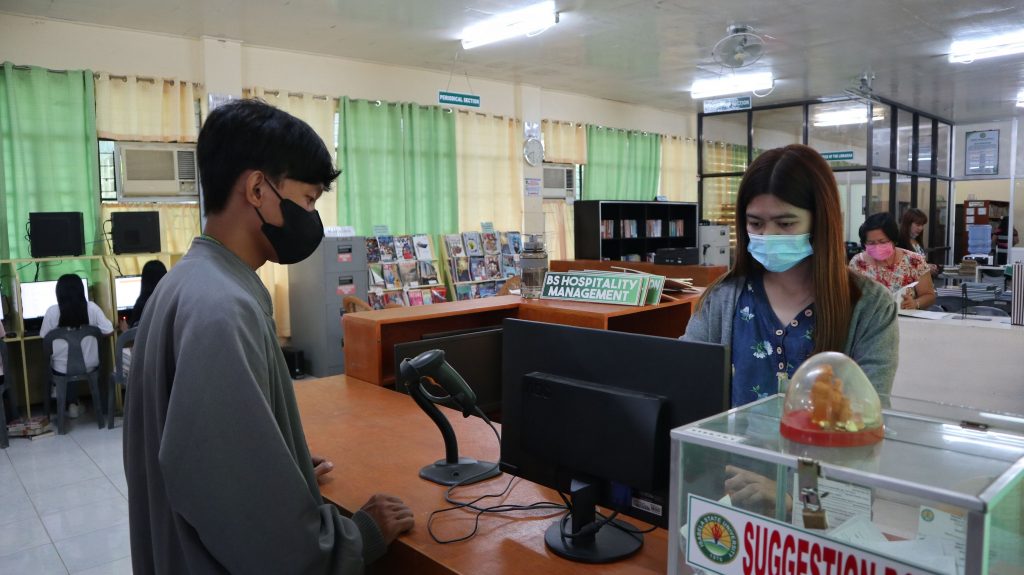
The main developer of TIME CATCH using EAMS, Mr. Ronald B. Rivera, has penned yet another chapter in his catalog of innovations by pioneering the Electronic Library with Attendance Monitoring System for the Isabela State University- Angadanan Campus Library.

This ingenious creation, akin to turning pages in a captivating novel, is rewriting the story of traditional library management. Like a well-crafted plot twist, this network-based system not only streamlines the tracking of library materials but also adds a layer of innovation, saving time and transforming the narrative of academic efficiency.
At its core, this system acts as a comprehensive solution for librarians, empowering them to efficiently keep track of library materials. The tedious and time-consuming manual paperwork associated with bookkeeping becomes a relic of the past, as the system automatically records and updates information about books, allowing librarians to allocate resources more effectively. Simplifying the process of book allocation and payment, the Electronic Library with Attendance Monitoring System is not only a time-saving tool but also a catalyst for a more organized and resourceful learning environment.

SDG 4 finds resonance in the system with its ability to benefit students, professors, visitors, and librarians alike. By providing a centralized hub for information, including book details, journal information, classifications, categories, statistical dashboards, circulations, inventory, and auto-generated reports, the system ensures that everyone in the academic community has easy access to a wealth of knowledge.
Additionally, the system champions SDG 9, emphasizing Industry, Innovation, and Infrastructure. The introduction of innovative solutions, such as barcode utilization for book searches, timely auto-generated reports, and statistical dashboards, not only streamlines processes but also represents a digital transformation in library management.

The advantages of this system are multifaceted. Beyond the reduction of manual paperwork and the automatic recording of book information, librarians gain the ability to manage book availability and arrivals efficiently. The utilization of barcode technology facilitates a customer-friendly experience, enabling easy book searches. Furthermore, the timely auto-generated reports and statistical dashboards provide immediate insights, aiding librarians in making informed decisions and fostering continuous improvement.
The system was implemented in 2021 during Mr. Rivera’s first year at the university. He shared that it was a meticulous process anchored in the recommendations of the AACCUP accreditors. The establishment of the system’s infrastructure involved intricate networking and the setup of multiple encoding stations within the computer laboratory, a collaborative effort with students that brought Mr. Rivera’s visionary concept to tangible fruition.

Following this groundwork, barcode IDs for students were systematically generated and printed, aligning seamlessly with the accreditors’ recommendations, which also encompassed the tracking of library attendance. The formerly intricate processes of borrowing and returning books underwent a paradigm shift, evolving into a streamlined experience through the implementation of barcode scanning, complete with penalty enforcement for overdue items. Auto-generated reports, like chapters in an unfolding story, provide valuable insights that can be accessed by the librarian at the click of a button.
As the system reached full operational capacity in the midyear of 2021, around August-July, it marked the beginning of a transformative journey that has continued for three years. Yet, Mr. Rivera, the author of this technological saga, does not rest on his laurels. He envisions a potential future project—an Asset Management Information System for the campus, a system designed to track the shelf life and disposal of assets, emphasizing his commitment to innovation and holistic campus management.

In an interview, Mr. Rivera revealed the ongoing progress of his TIME CATCH system, now in its third version. Although awaiting supplies for deployment, this showcases his continuous dedication to pushing technological boundaries, ensuring that the campus remains at the forefront of innovation.
In the grand library of technological advancements at ISU-AC, ELAMS stands as a shining chapter in the ongoing saga of innovation. This page-turner technology has truly transformed the landscape of library management. As we continue to navigate the pages of progress, this serves as a testament to ISU-AC’s commitment to fostering an environment where perpetual advancement is highly encouraged.
With each innovation, the campus continues to pen a compelling story of growth and adaptability, leaving us excitedly anticipating the unfolding chapters of future innovations that lie ahead.


